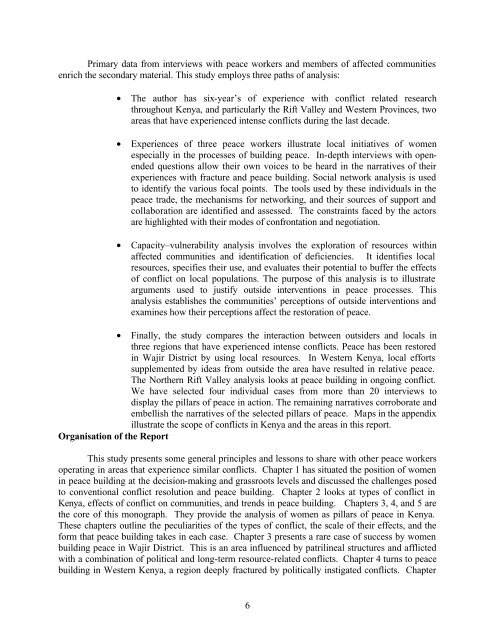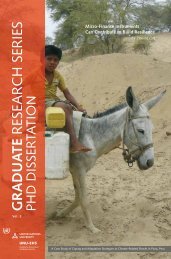Unveiling Women as Pillars of Peace Peace Building in ...
Unveiling Women as Pillars of Peace Peace Building in ...
Unveiling Women as Pillars of Peace Peace Building in ...
Create successful ePaper yourself
Turn your PDF publications into a flip-book with our unique Google optimized e-Paper software.
Primary data from <strong>in</strong>terviews with peace workers and members <strong>of</strong> affected communities<br />
enrich the secondary material. This study employs three paths <strong>of</strong> analysis:<br />
• The author h<strong>as</strong> six-year’s <strong>of</strong> experience with conflict related research<br />
throughout Kenya, and particularly the Rift Valley and Western Prov<strong>in</strong>ces, two<br />
are<strong>as</strong> that have experienced <strong>in</strong>tense conflicts dur<strong>in</strong>g the l<strong>as</strong>t decade.<br />
• Experiences <strong>of</strong> three peace workers illustrate local <strong>in</strong>itiatives <strong>of</strong> women<br />
especially <strong>in</strong> the processes <strong>of</strong> build<strong>in</strong>g peace. In-depth <strong>in</strong>terviews with openended<br />
questions allow their own voices to be heard <strong>in</strong> the narratives <strong>of</strong> their<br />
experiences with fracture and peace build<strong>in</strong>g. Social network analysis is used<br />
to identify the various focal po<strong>in</strong>ts. The tools used by these <strong>in</strong>dividuals <strong>in</strong> the<br />
peace trade, the mechanisms for network<strong>in</strong>g, and their sources <strong>of</strong> support and<br />
collaboration are identified and <strong>as</strong>sessed. The constra<strong>in</strong>ts faced by the actors<br />
are highlighted with their modes <strong>of</strong> confrontation and negotiation.<br />
• Capacity–vulnerability analysis <strong>in</strong>volves the exploration <strong>of</strong> resources with<strong>in</strong><br />
affected communities and identification <strong>of</strong> deficiencies. It identifies local<br />
resources, specifies their use, and evaluates their potential to buffer the effects<br />
<strong>of</strong> conflict on local populations. The purpose <strong>of</strong> this analysis is to illustrate<br />
arguments used to justify outside <strong>in</strong>terventions <strong>in</strong> peace processes. This<br />
analysis establishes the communities’ perceptions <strong>of</strong> outside <strong>in</strong>terventions and<br />
exam<strong>in</strong>es how their perceptions affect the restoration <strong>of</strong> peace.<br />
• F<strong>in</strong>ally, the study compares the <strong>in</strong>teraction between outsiders and locals <strong>in</strong><br />
three regions that have experienced <strong>in</strong>tense conflicts. <strong>Peace</strong> h<strong>as</strong> been restored<br />
<strong>in</strong> Wajir District by us<strong>in</strong>g local resources. In Western Kenya, local efforts<br />
supplemented by ide<strong>as</strong> from outside the area have resulted <strong>in</strong> relative peace.<br />
The Northern Rift Valley analysis looks at peace build<strong>in</strong>g <strong>in</strong> ongo<strong>in</strong>g conflict.<br />
We have selected four <strong>in</strong>dividual c<strong>as</strong>es from more than 20 <strong>in</strong>terviews to<br />
display the pillars <strong>of</strong> peace <strong>in</strong> action. The rema<strong>in</strong><strong>in</strong>g narratives corroborate and<br />
embellish the narratives <strong>of</strong> the selected pillars <strong>of</strong> peace. Maps <strong>in</strong> the appendix<br />
illustrate the scope <strong>of</strong> conflicts <strong>in</strong> Kenya and the are<strong>as</strong> <strong>in</strong> this report.<br />
Organisation <strong>of</strong> the Report<br />
This study presents some general pr<strong>in</strong>ciples and lessons to share with other peace workers<br />
operat<strong>in</strong>g <strong>in</strong> are<strong>as</strong> that experience similar conflicts. Chapter 1 h<strong>as</strong> situated the position <strong>of</strong> women<br />
<strong>in</strong> peace build<strong>in</strong>g at the decision-mak<strong>in</strong>g and gr<strong>as</strong>sroots levels and discussed the challenges posed<br />
to conventional conflict resolution and peace build<strong>in</strong>g. Chapter 2 looks at types <strong>of</strong> conflict <strong>in</strong><br />
Kenya, effects <strong>of</strong> conflict on communities, and trends <strong>in</strong> peace build<strong>in</strong>g. Chapters 3, 4, and 5 are<br />
the core <strong>of</strong> this monograph. They provide the analysis <strong>of</strong> women <strong>as</strong> pillars <strong>of</strong> peace <strong>in</strong> Kenya.<br />
These chapters outl<strong>in</strong>e the peculiarities <strong>of</strong> the types <strong>of</strong> conflict, the scale <strong>of</strong> their effects, and the<br />
form that peace build<strong>in</strong>g takes <strong>in</strong> each c<strong>as</strong>e. Chapter 3 presents a rare c<strong>as</strong>e <strong>of</strong> success by women<br />
build<strong>in</strong>g peace <strong>in</strong> Wajir District. This is an area <strong>in</strong>fluenced by patril<strong>in</strong>eal structures and afflicted<br />
with a comb<strong>in</strong>ation <strong>of</strong> political and long-term resource-related conflicts. Chapter 4 turns to peace<br />
build<strong>in</strong>g <strong>in</strong> Western Kenya, a region deeply fractured by politically <strong>in</strong>stigated conflicts. Chapter<br />
6



